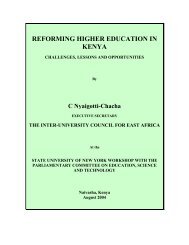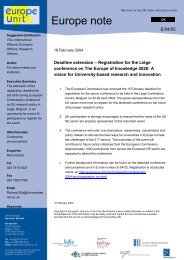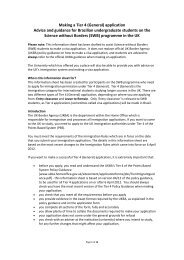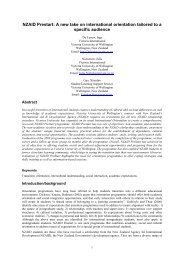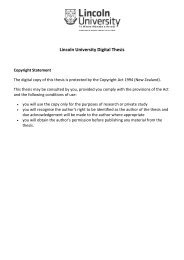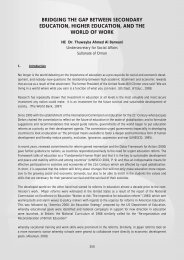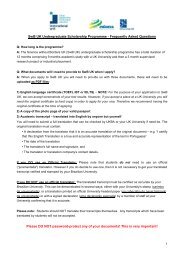POSITIONING TO MEET GLOBAL COMPETITION: THE HIGHER ...
POSITIONING TO MEET GLOBAL COMPETITION: THE HIGHER ...
POSITIONING TO MEET GLOBAL COMPETITION: THE HIGHER ...
You also want an ePaper? Increase the reach of your titles
YUMPU automatically turns print PDFs into web optimized ePapers that Google loves.
International forum: “Globalization and Integration in higher education”<br />
are and from where they are coming. An assessment of the available resources will<br />
explain further one’s current position. To understand essential abilities and potentials, it is<br />
necessary to audit current resources (staff, skills, budget, technology, equipment),<br />
management infrastructure (strategies, policies, structure, systems, and processes), and<br />
leadership visions and values.<br />
Most marketing experts suggest the use of a perceptual map in identifying current<br />
position. A perceptual map helps situate an institution using criteria relevant in meeting<br />
competition. Although this paper does not elaborate on perceptual maps, it mentions it is<br />
an alternate tool.<br />
Second, identify the desired position. The best starting point in staking a position<br />
originates from one’s vision and mission. The vision from the words of one author is the<br />
magnetic north. This is what one aspires to become as a higher education institution. The<br />
mission is what makes for uniqueness. The vision and mission are the embodiment of<br />
stakeholders’ aspiration. Without them, an institution will strike whichever way in the<br />
face of globalization. This can mean a waste of vital resources, and high frustration for<br />
not getting to where one really wants to be.<br />
The perception of one’s place and role in the global higher education landscape is<br />
determined by the reputation one wants to establish in the future. It is practically rooted<br />
from what is current, but goes beyond with a hope for what may be feasible. American<br />
universities, though now severely challenged, are still perceived as being in the top rung<br />
of the higher education ladder. Australian universities currently have the perception of<br />
being strong contenders with their blend of relevant programs and high quality research.<br />
European universities are evidently regrouping to capture a better place in the global<br />
market. The aspiration of higher education institutions in developing countries, in this<br />
regard, is not evident.<br />
One practical position that seems compelling to developing countries, given obtaining<br />
conditions, is a market niche. This is equivalent to identifying the small pond upon which<br />
one can be the big frog. A niche is defined as a more narrowly defined group seeking a<br />
distinctive mix of benefits (Kotler, 2003). An attractive niche is characterized as having<br />
customers with a distinct set of needs, willingness of the customers to pay for a premium,<br />
the unlikelihood of the niche attracting other competitors, economies obtained through<br />
specialization, and the niche has size, profit, and growth potential.<br />
Establishing a niche means defining the market in which one intends to compete<br />
effectively. There are already established players in the global higher education ballgame.<br />
It is nonsensical for developing countries to lay a stake on that which the big leaguers<br />
already dominate. Effectively positioning higher education institutions in the developing<br />
countries means taking a pragmatic view of one’s own territory. It is realistically targeting<br />
a space that is possible within the rules of the game and within one’s own set of<br />
capabilities. Niching is recognizing one’s current position and not being overly ambitious.<br />
The current position is the hinge upon which future position can swivel. Kotler (2003)<br />
suggests that multiple niching i.e., specializing on a number of attributes in the higher<br />
education market, can have a higher chance of longer-term survival than single niching.<br />
Third, determine value and leverage. Value corresponds to one’s strengths and the<br />
promising opportunities that one can leverage on. It is essential to know exactly what<br />
one’s strengths are. It may be any of the following: normative- something one is doing<br />
that is theoretically correct; historical- something that over time one has exhibited a





